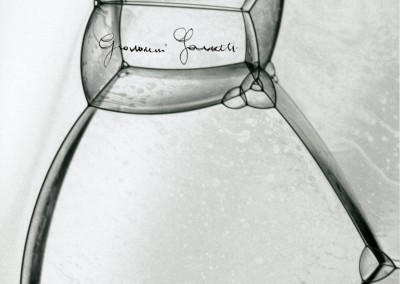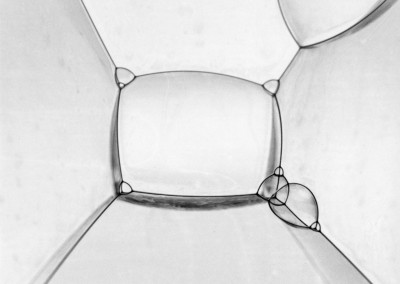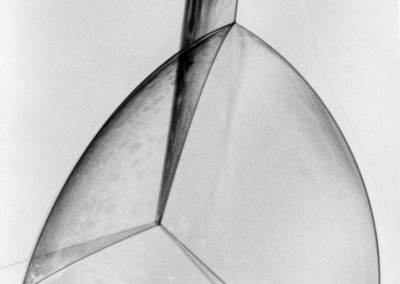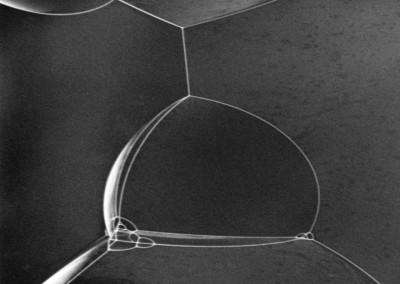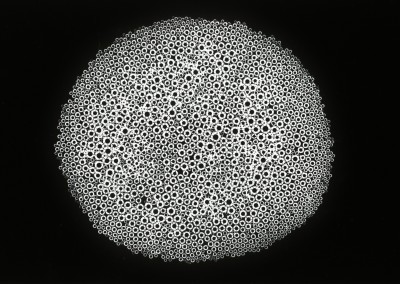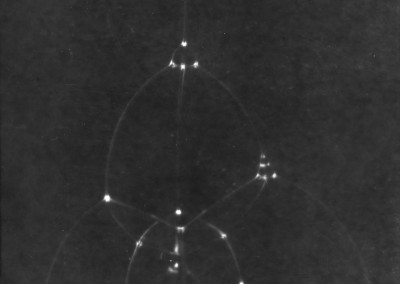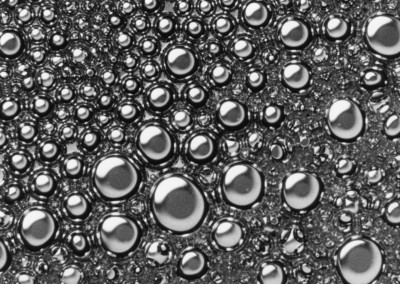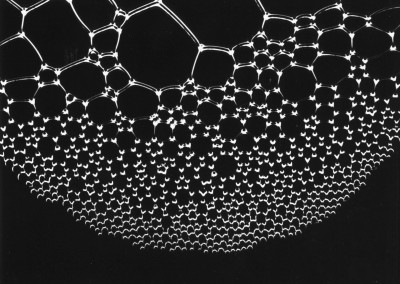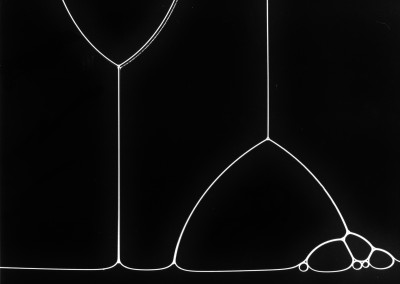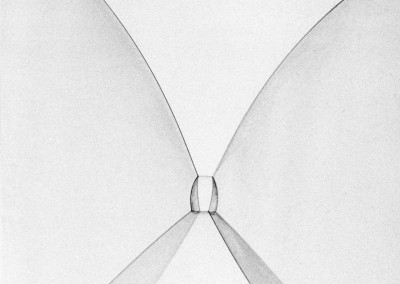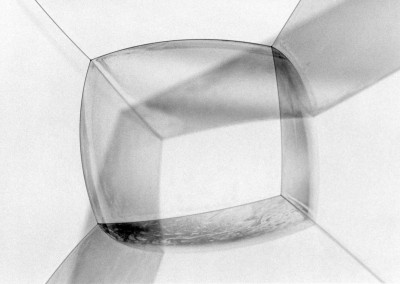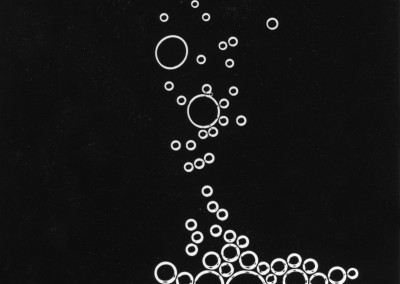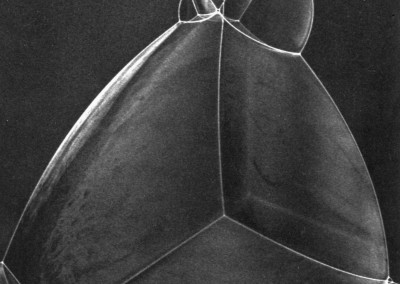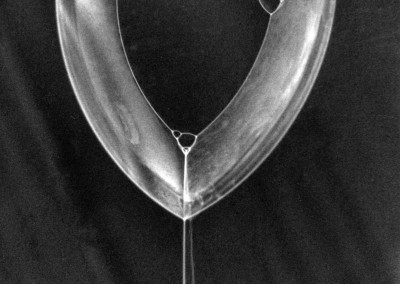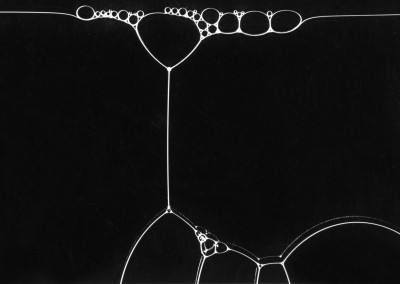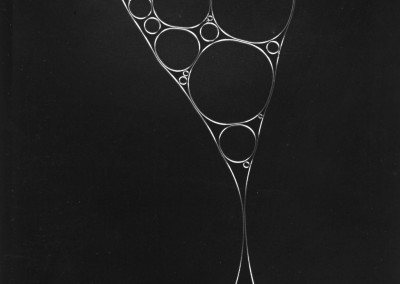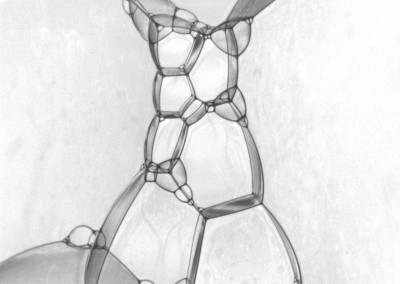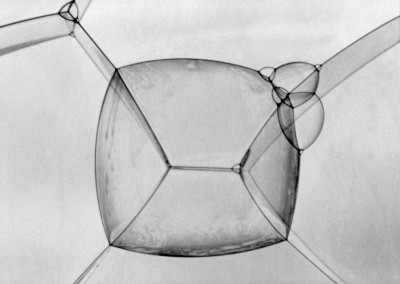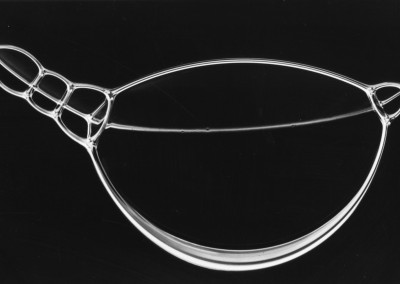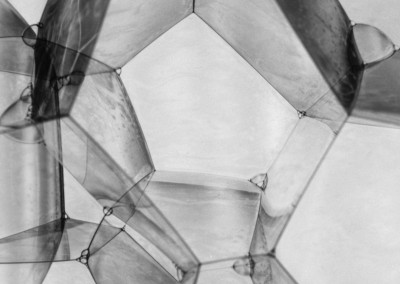Erano Bolle di Sapone 1987 – 1997
Bolla di sapone…Astuccio trasparente d’un sospiro… (Trilussa).
Aveva ragione Mark Twain quando scriveva: “una bolla di sapone è la cosa più bella, e la più elegante che ci sia in natura… Mi chiedo quanto denaro sarebbe necessario per comprare una bolla di sapone se al mondo ne esistesse soltanto una”.In natura le forme delle cose non sono casuali, ma rispondono a leggi esatte che tengono rigorosamente conto degli stati di aggregazione delle materie di cui sono composte. Così è a partire dalle particelle infinitamente piccole ai composti più macroscopici. E queste forme sono quanto di meglio esista in fatto di stabilità; nessun architetto per quanto geniale può inventare forme d’altrettanta perfezione. Personalmente credo non esista forma “creata” dall’uomo che non sia esistita ed esista nell’universo. Da questo aspetto a noi è dato soltanto di copiare. Anche l’acqua saponata tende quindi a sistemarsi in pellicole trasparenti con riflessi iridati secondo quelle leggi.
Giovanni Fanetti, prima ancora di essere un fotografo di qualità, è un curioso, perché in lui sono presenti intelligenza ed innocenza. Quell’innocenza propria dei bambini, pronta ad essere afferrata dallo stupore provando meraviglia davanti ad ogni cosa gli capiti di osservare e di coglierne immediatamente i significati ed i significanti profondi, che sono gli aspetti alla base dell’emozione nel suo nascere, farsi grande e divenire al tempo stesso coscienza e conoscenza.
Da qui si capisce come egli non si fermi, non resti dentro un risultato ottenuto anche se di valore, ma cerchi, anzi trovi sempre nuovi mondi da esplorare che affronta senza esitazioni di sorta. Per contro la fotografia ci mostra come il cammino degli autori, anche di quelli di maggior rilievo, sia un procedere narrativo che ha un suo ritmo che è quello interno di ciascuno di loro, che si snoda nel tempo come un lungo cordone che apre il sipario, sempre più nettamente, sulle cose del mondo di cui essi sono testimoni privilegiati. Loro sono i cantori dei nostri giorni, gli aedi che narrano storie atroci e tenere, brutali e commoventi, lungo la loro strada che non permette deviazioni, con la coscienza, propria dei fotografi autentici, di raccontare, di mostrare, filtrare dalla loro intelligenza e sensibilità, tutte le storie, i fatti e le cose. La gratitudine che gli dobbiamo è enorme come il nostro debito. Questi sono i fotografi.
Capita qualche volta un intruso che, fotografo anche lui, non si accontenti, ma desideri qualcosa d’altro: appartiene al popolo dei curiosi. Quale altro strumento nato per vedere meglio, per osservare e capire meglio delle fotografie poteva scegliersi? Certo sarà un “anomalo”, ma quando un artista è normale?
Giovanni Fanetti è un “anomalo”. Queste immagini fotografiche che più ortodosse non si può, hanno dell’incredibile e lo fanno intendere al di là di ogni dubbio.
Sono tensioni, canti sul filo sottilissimo di melodie estreme armonizzate di itinerari imprevedibili eppure così giusti da non poterne immaginare il minimo mutamento. Sono la semplicità perfetta frutto di quelle leggi prima citate e non ammettono nient’altro che se stesse. Trarre da queste della poesia è fare l’arte.
Su un numero del mensile “Scienze”, è pubblicato un lungo articolo sulle bolle di sapone dove sono riprodotte alcune fotografie delle bolle indicate come esempi di valenza artistica: un confronto sarebbe umiliante per quei fotografi, se messe accanto agli esiti del Fanetti.
E pensare che Giovanni si affanna a ripetermi le difficoltà incontrate a fabbricarsi le sue bolle e più ancora a farle resistere quanto basta per poterle fotografare: ecco l’innocenza che non s’avvede dei miracoli che produce!
Luciano Ricci
Gennaio 2000
THEY WERE BUBBLES
In nature, the shape of things does not come about by chance but it respects precise laws which take into account the aggregation of material of which they are composed. This is a fact, from tiny particles to macroscopic compounds. And these shapes also vary in stability. No architect, no matter how brilliant he is, can possibly create such perfect shapes. For my part, I don’t believe that there is a shape created by man that hasn’t already existed or exists in the universe. So, we can only make copies. Even soapy water tends to form transparent films with coloured reflections according to those laws. Giovanni Fanetti, before being an illustrious photographer, is an inquirer, because he is both intelligent and naive. It is the innocence of children. Children are always ready to be grasped by astonishment, finding amazement at anything new and are immediately willing to understand the meaning and deeper meanings of things which are the aspects at the heart of the beginning of emotion, to become big and at the same time become awareness and knowledge. This is why he never stops, he never stays inside a perfect result, but he is always looking for, rather he always finds, new worlds to explore and which he faces without any kind of hesitation. On the other hand, photography shows us how the progress of authors, even the most important ones is a narrative procedure which has its own pace and which is inside each one of them. It loosens up in time, like a long rope which opens the curtain, always more clearly, on the things of the world to which they are privileged witnesses. They are the epic poets of our day, the Aoidos who narrate terrible and tender, brutal and moving stories travelling a route which does not allow for any detours, with that special photographer’s skill in relating, demonstrating and filtering from their intelligence and sensitivity, all the stories, facts and things. The gratitude and obligation we owe to them is great. These are photographers. Sometimes an intruder comes along, himself a photographer, who is not satisfied but is looking for something more. He belongs to the world of inquirers. What better instrument than photography could he have chosen for seeing better, observing and understanding. Of course he will be “odd”, but then when has an artist ever been normal? Giovanni Fanetti is “odd”. These photographs which appear to be normal have something of the incredible about them, and they let it be known without any shadow of a doubt. They are tension, songs on a fine line of melodies that harmonise with unexpected itineraries or are so right that it is impossible to imagine the slightest change. They are perfect simplicity, a result of those aforementioned laws that do not acknowledge anything else but themselves. The poem which comes from this is making art. A long article about bubbles was published in an edition of the monthly magazine “Science” and it contains some photographs of these bubbles as an example of artistic worth. Comparing these works to the photographs of Fanetti would be humiliating for these hotographers. And to think how Giovanni never tires of telling me how difficult it was to make his bubbles, and even worse make them last long enough to take the photographs. This is his naivety, the fact that he doesn’t realize that he produces miracles! Luciano Ricci January 2000Gli originali delle fotografie sono analogici.
Tutti i diritti riservati. Il materiale contenuto nel sito Web è protetto da copyright.
E’ fatto, pertanto, divieto di copiare, modificare, pubblicare, o distribuire per se stessi o per terzi senza autorizzazione scritta.

